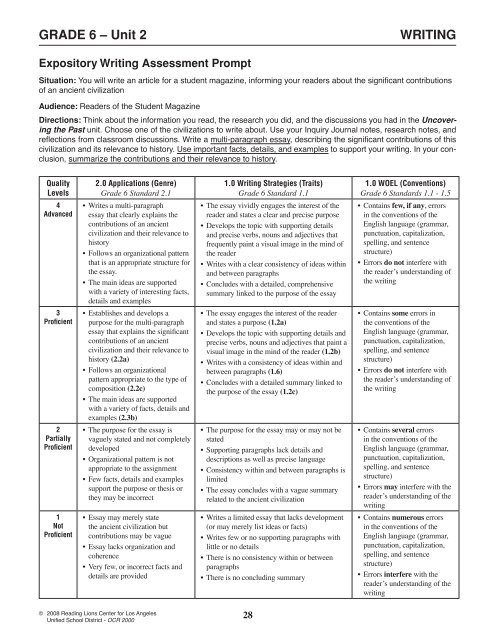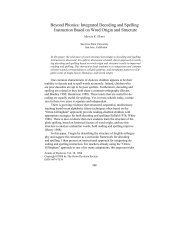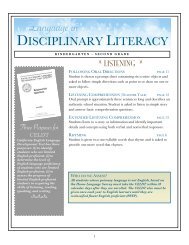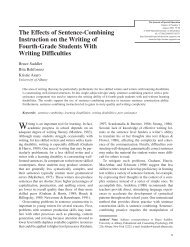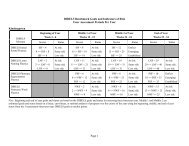WRITING GRADE 6 â Unit 2 - Elementary Literacy
WRITING GRADE 6 â Unit 2 - Elementary Literacy
WRITING GRADE 6 â Unit 2 - Elementary Literacy
Create successful ePaper yourself
Turn your PDF publications into a flip-book with our unique Google optimized e-Paper software.
<strong>GRADE</strong> 6 – <strong>Unit</strong> 2<strong>WRITING</strong>Expository Writing Assessment PromptSituation: You will write an article for a student magazine, informing your readers about the significant contributionsof an ancient civilizationAudience: Readers of the Student MagazineDirections: Think about the information you read, the research you did, and the discussions you had in the Uncoveringthe Past unit. Choose one of the civilizations to write about. Use your Inquiry Journal notes, research notes, andreflections from classroom discussions. Write a multi-paragraph essay, describing the significant contributions of thiscivilization and its relevance to history. Use important facts, details, and examples to support your writing. In your conclusion,summarize the contributions and their relevance to history.QualityLevels4Advanced3Proficient2PartiallyProficient1NotProficient2.0 Applications (Genre)Grade 6 Standard 2.1• Writes a multi-paragraphessay that clearly explains thecontributions of an ancientcivilization and their relevance tohistory• Follows an organizational patternthat is an appropriate structure forthe essay.• The main ideas are supportedwith a variety of interesting facts,details and examples• Establishes and develops apurpose for the multi-paragraphessay that explains the significantcontributions of an ancientcivilization and their relevance tohistory (2.2a)• Follows an organizationalpattern appropriate to the type ofcomposition (2.2c)• The main ideas are supportedwith a variety of facts, details andexamples (2.3b)• The purpose for the essay isvaguely stated and not completelydeveloped• Organizational pattern is notappropriate to the assignment• Few facts, details and examplessupport the purpose or thesis orthey may be incorrect• Essay may merely statethe ancient civilization butcontributions may be vague• Essay lacks organization andcoherence• Very few, or incorrect facts anddetails are provided1.0 Writing Strategies (Traits)Grade 6 Standard 1.1• The essay vividly engages the interest of thereader and states a clear and precise purpose• Develops the topic with supporting detailsand precise verbs, nouns and adjectives thatfrequently paint a visual image in the mind ofthe reader• Writes with a clear consistency of ideas withinand between paragraphs• Concludes with a detailed, comprehensivesummary linked to the purpose of the essay• The essay engages the interest of the readerand states a purpose (1.2a)• Develops the topic with supporting details andprecise verbs, nouns and adjectives that paint avisual image in the mind of the reader (1.2b)• Writes with a consistency of ideas within andbetween paragraphs (1.6)• Concludes with a detailed summary linked tothe purpose of the essay (1.2c)• The purpose for the essay may or may not bestated• Supporting paragraphs lack details anddescriptions as well as precise language• Consistency within and between paragraphs islimited• The essay concludes with a vague summaryrelated to the ancient civilization• Writes a limited essay that lacks development(or may merely list ideas or facts)• Writes few or no supporting paragraphs withlittle or no details• There is no consistency within or betweenparagraphs• There is no concluding summary1.0 WOEL (Conventions)Grade 6 Standards 1.1 - 1.5• Contains few, if any, errorsin the conventions of theEnglish language (grammar,punctuation, capitalization,spelling, and sentencestructure)• Errors do not interfere withthe reader’s understanding ofthe writing• Contains some errors inthe conventions of theEnglish language (grammar,punctuation, capitalization,spelling, and sentencestructure)• Errors do not interfere withthe reader’s understanding ofthe writing• Contains several errorsin the conventions of theEnglish language (grammar,punctuation, capitalization,spelling, and sentencestructure)• Errors may interfere with thereader’s understanding of thewriting• Contains numerous errorsin the conventions of theEnglish language (grammar,punctuation, capitalization,spelling, and sentencestructure)• Errors interfere with thereader’s understanding of thewriting© 2008 Reading Lions Center for Los AngelesUnified School District - OCR 200028
<strong>GRADE</strong> 6 – <strong>Unit</strong> 5<strong>WRITING</strong>Persuasive Writing Assessment PromptSituation: You noticed that your school does not have a paper-recycling program. You see this as an opportunity to save trees andmake money for the Student Council. Write a composition to persuade the Student Council to begin a paper-recycling program thatis managed by students.Audience: The Student CouncilDirections: Consider the selections you read in the Ecology unit and how human activities can disrupt the balance in the ecosystem.State your position in support of a paper-recycling program to save trees and maintain the balance in the ecosystem. Write a multipleparagraph essay to explain and support your position with logical arguments. Think about the Student Council’s opposing viewsand be sure your paragraphs include your counterarguments. Use supporting details and precise, descriptive vocabulary to painta visual image in the mind of the reader. Link your paragraphs with transitional words and phrases. In the concluding paragraph,summarize by explaining to the Student Council what you would like them to do.QualityLevels2.0 Applications (Genre)Grade 6 Standard 2.31.0 Writing Strategies (Traits)Grade 6 Standard 1.21.0 WOEL (Conventions)Grade 6 Standards 1.1 - 1.54Advanced• Establishes a clear, well-craftedposition in support of a paper recyclingprogram• Organization is clear and focusedfollowing a logical pattern• Highlights key points to make a logicaland convincing argument, citingrelevant evidence• Student Council’s (reader) concernsand counter-arguments are distinctlyand directly addressed• Creates a multiple-paragraph composition thattotally engages the reader and states a clearpurpose (the paper recycling program)• Develops the topic with vivid supporting detailsand precise descriptive vocabulary to paint avisual image in the mind of the reader• Provides dramatic details and transitionalexpressions that link one paragraph to anotherin a clear and well-focused line of thought• Concluding paragraph clearly states what theStudent Council should do• Contains few, if any, errorsin the conventions of theEnglish language (grammar,punctuation, capitalization,spelling, and sentencestructure)• Errors do not interfere withthe reader’s understanding ofthe writing3Proficient• States a clear position that supportsthe need for a paper recycling program(2.5a)• Supports the position with organizedand relevant evidence (2.5b)• Follows an appropriate organizationalpattern to convince the Student Council(2.2c)• Anticipates and addresses the StudentCouncil’s (reader) concerns andcounter-arguments (2.5c)• Creates a multiple-paragraph composition thatengages the reader and states a clear purpose(the paper recycling program) (1.2a)• Develops the topic with supporting details andprecise descriptive vocabulary to paint a visualimage in the mind of the reader (1.2b)• Uses a variety of effective and coherentorganizational patterns (1.3)• Concluding paragraph states what the StudentCouncil should do (1.2c)• Contains some errors inthe conventions of theEnglish language (grammar,punctuation, capitalization,spelling, and sentencestructure)• Errors do not interfere withthe reader’s understanding ofthe writing2PartiallyProficient• States a vague position that supportsthe need for a paper recycling program• Supports the position with weakarguments and evidence that may notbe relevant or conclusive• Organization is loosely constructed andmay not follow a logical pattern• Student Council’s concerns andcounter-arguments may be addressed• Writes a limited multiple-paragraphcomposition that alludes to a topic or purpose• Supporting paragraphs lack details, descriptionand/or precise language• Consistency within and between paragraphs islimited• Concludes with a weak or vague summarylinked to the purpose of the composition• Contains several errorsin the conventions of theEnglish language (grammar,punctuation, capitalization,spelling, and sentencestructure)• Errors may interfere with thereader’s understanding of thewriting1NotProficient• Proposal may or may not be stated• Proposal may or may not be supportedby any arguments or evidence• Organization is lacking or may be amere listing of statements• Student Council’s (reader) concernsand counter-arguments are notaddressed• Writes a limited multiple-paragraph or a singleparagraphcomposition that may or may notaddress the topic, the paper recycling program• Writes few or no supporting paragraphs withlittle or no details• Few transitional expressions are evident orparagraphs do not connect• There is no concluding paragraph stating whatthe Student Council should do• Contains numerous errorsin the conventions of theEnglish language (grammar,punctuation, capitalization,spelling, and sentencestructure)• Errors interfere with thereader’s understanding of thewriting© 2008 Reading Lions Center for Los AngelesUnified School District - OCR 200031


